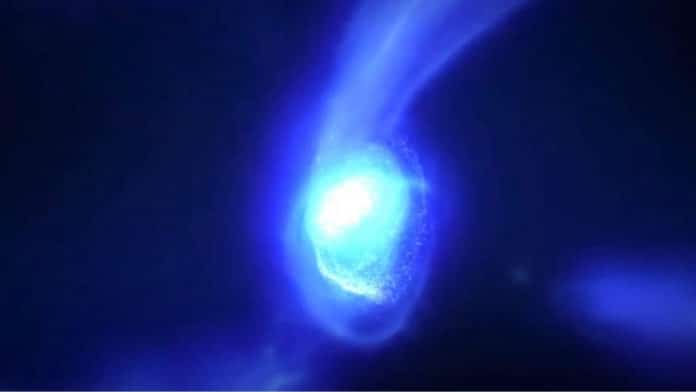With powerful telescopes, astronomers could detect more and more distant galaxies. Interestingly, they can estimate how fast a galaxy is moving and, in turn, when it was formed based on how “redshifted” its emission appears. This is similar to a phenomenon called the “Doppler effect,” where objects moving away from an observer emit the light that seems to be shifted towards longer wavelengths (hence the term “redshift””) to the observer.
The ALMA telescope is convenient for observing such redshifts in galaxy emissions. Recently, a team of international researchers, including Professor Akio Inoue and graduate student Tsuyoshi Tokuoka from Waseda University, Japan, Dr. Takuya Hashimoto at the University of Tsukuba, Japan, Professor Richard S. Ellis at University College London, and Dr. Nicolas Laporte, a research fellow at the University of Cambridge, UK, has observed redshifted emissions of a distant galaxy, MACS1149-JD1 (hereafter JD1).
Ellis said, “Beyond finding high-redshift, namely very distant, galaxies, studying their internal motion of gas and stars motivates understanding the process of galaxy formation in the earliest possible universe.”
Scientists successfully detected tiny variations in the “redshift” from position to position inside the galaxy throughout a series of observations over two months. They discovered that JD1 met the criteria for a universe dominated by rotation. The galaxy was then represented as a revolving disc, and scientists found that this model successfully captured the findings.
Compared to the Milky Way disk’s rotational speed of 220 kilometers per second, the calculated rotational speed was roughly 50 kilometers per second. The study also determined that JD1 has a far smaller diameter than the Milky Way, which is 100,000 light-years across, at only 3,000 light-years.
Their discovery that JD1 has a revolving disc of gas and stars makes it the farthest-reaching and, hence, the earliest source ever discovered. This has enabled scientists to outline the slow development of rotating galaxies throughout more than 95% of cosmic history, in conjunction with analogous measurements of nearby systems in the academic literature.
Furthermore, the mass estimated from the galaxy’s rotational speed was in line with the stellar group previously calculated from the galaxy’s spectral signature. It came predominantly from “mature” stars that formed about 300 million years ago.
Hashimoto said, “This shows that the stellar population in JD1 formed at an even earlier epoch of the cosmic age.”
Inoue said, “The rotation speed of JD1 is much slower than those found in galaxies in later epochs and our Galaxy, and it is likely that JD1 is at an initial stage of developing a rotational motion.”
Journal Reference:
- Tsuyoshi Tokuoka et al. Possible Systematic Rotation in the Mature Stellar Population of a z = 9.1 Galaxy. DOI: 10.3847/2041-8213/ac7447
